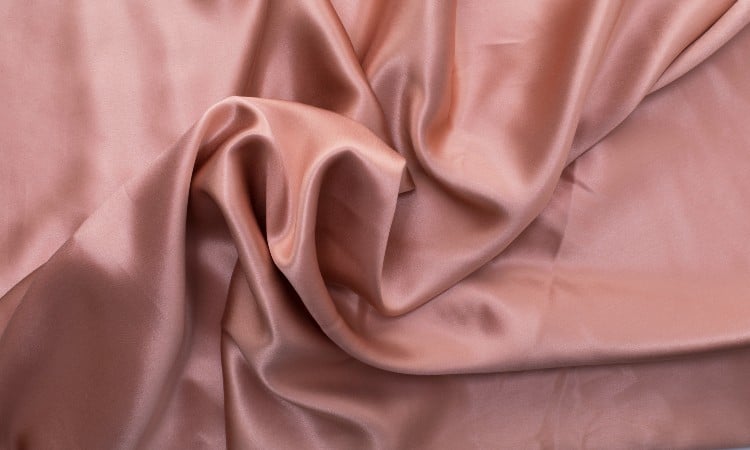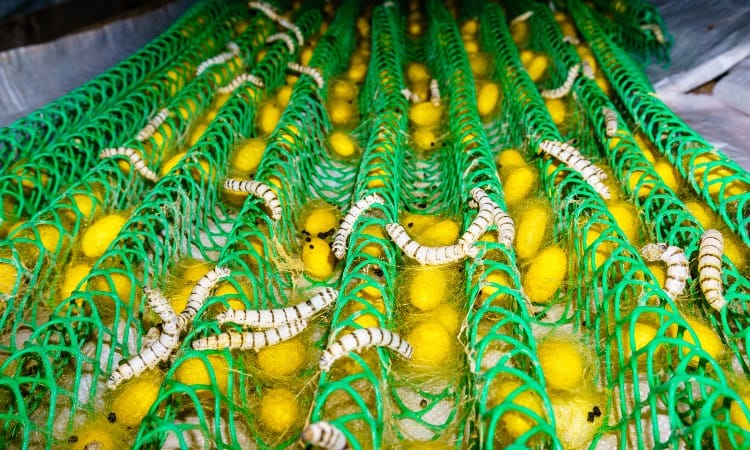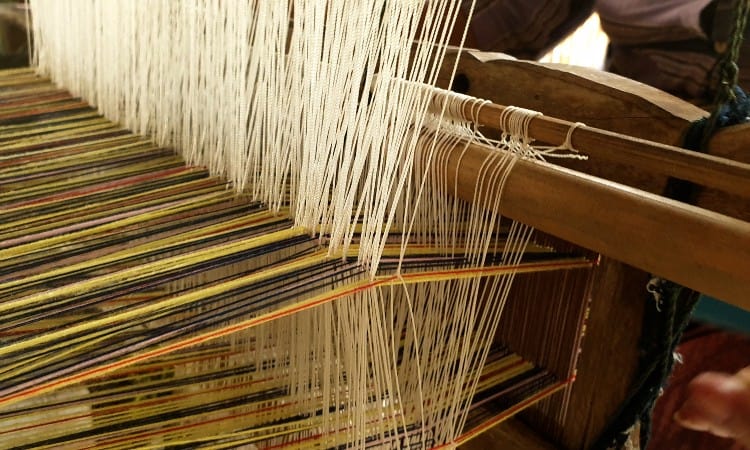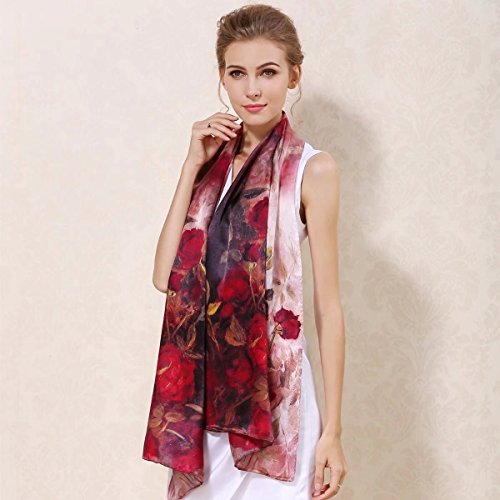Humans have found fibers in the natural world in various unexpected places, from plants to animals and even insects. One of the most common insect-produced fibers in the world is silk, and the best silk is mulberry silk. But what is mulberry silk, and what makes it so special?
Mulberry silk is a fiber that comes from the cocoons of a specific kind of moth, the Bombyx mori. These moths make a strong, odorless, pure white fiber for their cocoons. The fiber from these cocoons makes a fine, smooth textured fabric that humans have used for thousands of years.
Not all silk comes from the same source, however. Many different insects make silk, but not all of it is useful for fabrics. This guide will show you what sets mulberry silk apart from other kinds of silk and tell you why it’s the most widely used variety today.

What Is Mulberry Silk Fabric?
 Mulberry silk fabric is a fabric made from domesticated silkworms. These worms are the caterpillar form of the Bombyx mori moth. The domesticated moths only eat mulberry leaves, hence the name mulberry silk.
Mulberry silk fabric is a fabric made from domesticated silkworms. These worms are the caterpillar form of the Bombyx mori moth. The domesticated moths only eat mulberry leaves, hence the name mulberry silk.
The secretion that they use to make their cocoons is a fine thin fiber. It’s pure white and is one long unbroken thread. Using this fiber to weave cloth makes a smooth, luxurious fabric. Mulberry silk is one of the finest, most expensive silks on the market.
Undyed mulberry silk is pure white and incredibly smooth and strong. It’s a uniform, durable, and soft silk fabric.
Mulberry silk is also one of the oldest types of silk fabric. Thousands of years ago, the Chinese developed silk manufacturing, called sericulture, beginning with harvesting silk from wild moths. Eventually, they domesticated the Bombyx mori moth exclusively for use in producing silk.
What Is Mulberry Silk Made Of?

Mulberry silk is made from unraveled Bombyx mori moth cocoons. Silk is a protein fiber that moths produce when they are in their caterpillar, or larval, stage. It’s a durable and useful substance that protects the moths from fungal and bacterial infections, regulates their temperature, and keeps dust and debris away while they transform.
Those same protective qualities the cocoon gives the moth are one of the reasons that silk makes a good textile. Mulberry silk is particularly useful because it is the longest unbroken silk fiber that exists. Cocoons are a single strand of silk wrapped around and around. Unraveled, they can measure as long as one and a half kilometers (just over 1,640 yards).
Because the domesticated moths only eat mulberry leaves, it keeps their silk a uniform color and strength. Typically, silk manufacturers do not use the outermost coil of the cocoon to weave fabric, however, because it is exposed to the elements and may be damaged or slightly discolored.
How Is Mulberry Silk Made?

Silk is a critical part of a Bombyx mori moth’s life cycle. Without it, they cannot reach maturity and reproduce, and without them reproducing, there is no way to continue making mulberry silk. They are domesticated, meaning human intervention has changed the way they live and reproduce, and as a result, there are two distinct ways that humans gather the silk they produce.
The traditional way is to harvest the silk while the moth is still in the cocoon. This leaves the silk strand undamaged and gives you a much longer fiber to work with. Manufacturers who use this method will typically boil the cocoons, which kills the moths. Then, they brush the outside of the cocoon until they find the end of the fiber and unravel the cocoon. Some people use the moth inside as a food source.
The other way of harvesting the silk is called Ahimsa, or Peace silk. In this method, manufacturers wait until the silkworm matures and makes a hole in the cocoon to emerge as a moth. The hole breaks the silk strand into several pieces of various lengths, but it doesn’t harm the moth.
Once the cocoon is unraveled, manufacturers weave the strands into the fabric one way or the other. There are a variety of weaving techniques that manufacturers can use with these fibers. Mulberry silk refers more to the type of fiber than the weaving technique.
What Are the Characteristics of Mulberry Silk?
 Mulberry silk stands out among other silks for its smooth texture, durability, and hypoallergenic qualities. The smoothness and softness come from the long, uniform length of the individual fibers.
Mulberry silk stands out among other silks for its smooth texture, durability, and hypoallergenic qualities. The smoothness and softness come from the long, uniform length of the individual fibers.
The long fibers make the surface of the finished fabric smoother. Manufacturers can spin the fiber into much longer threads than with other natural fibers. Silk is the only natural filament fiber. Individual filament fibers are continuous lengths. Unlike staple fibers, which are shorter fibers spun together, there aren’t any uneven or lumpy spots in a filament fiber that could catch on your skin or hair.
The durability comes from the strength of the cocoon fibers and their natural protective qualities. The characteristics that keep the moth safe also benefit humans who use the fibers. Each silk strand has the same tensile strength as the steel of the same size and weight.
In addition to the strength, the cocoon silk is antimicrobial and antifungal, so the fabric will stay fresher for longer. The silk is naturally odorless, and the protein in the fiber (sericin) is biocompatible with humans, meaning it rarely causes irritation or allergic reaction. This makes mulberry silk a perfect option if you have sensitive skin or are allergy-prone.
Is Mulberry Silk Real Silk?
Mulberry silk is real silk. Like all silk, it comes from moth cocoons. The moths that produce wild silk and other varieties of silk are related to one another. What makes the mulberry silk unique is the diet the moths eat—exclusively mulberry leaves.
Many common silks with other names are made of mulberry silk, and their name refers to the weaving technique rather than the fiber. Charmeuse and crepe de chine silk are both made with mulberry silk fibers. They get their names from the production method and the characteristics those methods produce.
What makes mulberry silk different from other silks is the uniform quality of the fibers. The diameter, color, and texture of a strand of mulberry silk are the same from one cocoon to another. Wild silks and silks from insects that have a broader diet can vary from strand to strand.
The term silk refers to any protein fiber produced by an insect. Few of these silks are used for textiles. In comparing mulberry silk vs silk, you’re comparing different insects, but both products are still real silk.
Manufacturers can produce synthetic silk and fibers that mimic silk qualities, but all real silk comes from an insect, usually a moth.
Advantages and Disadvantages of Mulberry Silk
 Mulberry silk has many advantages as a textile, including its strength and texture. It has a luxurious feel without being too delicate to be useful. The smooth surface is also soft enough to wear next to your skin or for use as bedding.
Mulberry silk has many advantages as a textile, including its strength and texture. It has a luxurious feel without being too delicate to be useful. The smooth surface is also soft enough to wear next to your skin or for use as bedding.
The pure white color cuts down on the number of processes needed to dye it, so it comes in a wide variety of colors and patterns. It’s glossy on the surface without adding metallics or other materials. Regardless of how manufacturers spin the fibers, the resulting fabric is lustrous, strong, and supple with an excellent drape.
It’s also a great insulator while still being breathable. The fiber structure that helps the moth regulate their temperature inside the cocoon also helps the fiber trap your body heat or wick moisture away from your skin when used in textile.
The greatest disadvantage of mulberry silk is the expense. Even with a single moth producing a large amount of fiber for its cocoon, it still takes several thousand cocoons to make each pound of silk. Some Bombyx mori can lay eggs multiple times a year, but others only do so once a year. As a result, it takes billions of moths to create the world’s silk supply.
After the moths make the silk, the harvest also takes considerable processing to unspool the cocoons. Whether the moths are killed or not, unspooling the cocoons is labor-intensive. The other primary disadvantage is that the vast majority of silk production does harm the moths, which some people find unethical.
What Is Mulberry Silk Used for?
 Mulberry silk is the most common type of silk on the market, so it is used in many textile products. For garments, it is usually used in more formal or expensive items due to the high cost of the fabric. Wedding dresses, black tie attire, and the linings for high-fashion coats and jackets are frequently made of silk.
Mulberry silk is the most common type of silk on the market, so it is used in many textile products. For garments, it is usually used in more formal or expensive items due to the high cost of the fabric. Wedding dresses, black tie attire, and the linings for high-fashion coats and jackets are frequently made of silk.
High-end home décor and upholstery are sometimes made with silk, too. It’s durable enough for frequent use on furniture, and the shine and dye capabilities make it visually interesting for wall hangings or curtain elements.
It’s also commonly used for luxury bedding. The hypoallergenic qualities and the extremely soft feel make it good for comfortable sleep. The smoothness also helps protect hair from breakage when used for pillowcases.
Outside of the textile industry, silk has some medical applications. It’s strong and biocompatible but won’t dissolve in the body or get incorporated into the skin, so it makes a good thread for stitches and sutures that doctors can remove once the body heals.
Sewing Tips for Mulberry Silk
Despite the tensile strength of silk fibers, mulberry silk can be tricky to sew. Depending on the weave, it tends to unravel, and it’s fine enough that pins and needles can leave permanent holes or snags in the fabric if you aren’t careful.
It’s also a very slippery fabric, so cutting it and working complex seams can be challenging. The best ways to combat this are with extra planning and a few clever workarounds.
First, make sure to check the care instructions for your silk. Some silks are machine-washable, but others will get permanent water spots or stains if you expose them to too much moisture. Knowing whether or not your mulberry silk can handle pressing or steaming without a protective pressing cloth is important. When in doubt, use a heavier pressing cloth to protect it from the steam.
Second, measure and fit the garment carefully before you cut or make any seams. If you need to pin the fabric, use silk pins, which are narrow and very sharp. These will reduce the number of pinholes and snags. To cut, use weights instead of pins. Avoid scissors, using a rotary cutter instead.
To stop the raw edges from unraveling too much, you can surge the ends or add interfacing, depending on your seam allowances and how the allowance will sit in the garment. Err on the side of a larger seam allowance whenever possible.
Use a very sharp, fine needle, whether you’re hand sewing or machine sewing. Test it on a scrap piece of silk first to make sure there aren’t issues. The best sizes are #60 or #70, and if you can use a new needle for every new silk project, you’ll get better results.
Finally, go slowly and check everything twice before you sew each seam. If you have to rip out a seam, it can leave behind needle marks that you won’t be able to smooth out. It takes more time upfront but making sure you only sew each seam once will keep your silk fabric pristine.
Where to Buy Mulberry Silk Fabric?
Even though mulberry silk is expensive, it isn’t uncommon. Most local fabric stores will carry it, as do online commercial and wholesale retailers. However, not every silk fabric is mulberry silk. If a listing says it is 100% silk, that just means it is from an insect secretion.
Reputable retailers will tell you the source of the silk in the listing. Listings that have terms like habotai, dupioni, or telio are different from mulberry silk. Weave types, like crepe de chine, don’t necessarily mean the silk is mulberry, so check those as well.
If you’re shopping online for fabric, check all the details of the listing carefully. If the listing doesn’t say mulberry silk, you can’t guarantee it is. If you’re shopping in person, look for the fabric label or talk to a store associate to verify that the silk fabric is mulberry or another type of silk.
Mulberry Silk By the Yard
Mulberry silk starts at about $20 per yard, which is on the high end of the price range for garment fabrics. Depending on the dye, treatments, and the weaving technique, some mulberry silk fabrics can cost as much as $70 per yard.
The heavier the silk and the more complex the weave, the more expensive the fabric is. Regardless of thickness, silk fabric is sold in narrower widths than many other garment fabrics. The typical width of a linear yard of silk is 44 inches, though some are as wide as 54 inches.
Double-width silk is rarely available. Silk fabric wider than 54 inches is less likely to be 100% mulberry silk, and if it is, it will be much more expensive than single-width silk of the same weight.
Conclusion
For thousands of years, mulberry silk has been the luxury fabric of choice for many people. As strong as it is beautiful, this fabric harnesses the natural benefits of an incredible insect to make a textile that benefits humans just as much.